Game Thinking as a Strategy to Promote Deep Learning in Any Field
While observing my students in Cégep Limoilou’s Video Game Design program, I noticed their ability to mobilize a specific skill set comprising critical analysis, problem solving and creativity. As I built the generic course plan for a new course, English for Video Game Design II, I included a gamification project to specifically hone these skills, often referred to as game thinking. After testing this approach with my students in the fall 2017 term, I am convinced it can benefit students in virtually any program.
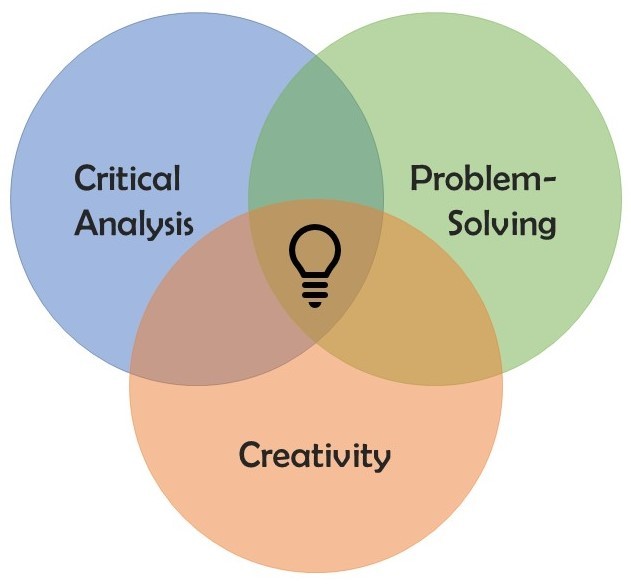
Game thinking mobilizes 3 skills that are essential for college students
The gamification project in my course spanned 8 weeks, as follows:
- Week 1
- Introduction to the project. Students do a web search to better understand gamification and start brainstorming a topic.
- Week 2
- Students confirm their choice of topic and investigate it in depth.
- Week 3
- Students question themselves and their peers to better understand learners’ challenges and needs.
- Week 4
- Each student summarizes a selected theoretical resource on gamification and presents a critical review of an existing platform. These documents are shared with the other team members.
- Week 5
- Gamification workshop. Students are introduced to the practical elements of a gamified approach, and consider which ones are relevant to them.
- Week 6 & Week 7
- Students collaborate on their team project. The teacher is available to answer questions and give feedback.
- Week 8
- Each team presents their concept in a short presentation. The other teams complete peer assessment forms. Based on this feedback, students make changes to their written presentation document, submitted 1 week later.
The length of the project can easily be adapted based on the scope of the topics and the assignments involved.
Game Thinking Makes Learning More Relevant and Motivating
At the start of the gamification project, each student had to identify a language item they struggled with; for instance, verb tenses, syllable stress, paragraph structure, etc. Inspired by Self-Determination Theory, I wanted students to critically consider a topic they were interested in investigating. Of course, a teacher could also assign a more specific focus.
Student motivation is always at the heart of my concerns when planning or teaching a course; without it, teaching is ineffective at best, or does not happen at all. It is now generally acknowledged that games keep learners engaged and motivated. As I started elaborating the project, I realized its potential extends far beyond an increase in motivation, as it allows students to:
- identify essential knowledge in regard to the subject matter.
- gain an understanding of the pain points they struggle with.
- hone their critical thinking and problem-solving skills.
- exploit their creativity in a collaborative context.
Game thinking involves using a problem-solving mindset to design game-like environments that enable users to learn about or solve real-world problems even as they have fun.
Game Thinking Consolidates Metacognition
After pinpointing a learning topic (a language item) to work on, students worked in teams to investigate it in depth:
- They reviewed salient theory and information in their course notes and other resources.
- They identified their own pain points and brainstormed strategies to address these.
- They interviewed peers (in this case, students enrolled in my other classes) to find out their needs in regard to the chosen language item.
- They met with me to ask their questions and receive feedback.
These steps were essential to validate the teams’ understanding of the declarative and procedural knowledge comprising the topic they focused on, before developing their gamified concept. In order to achieve this, they had to harness their own cognitive and metacognitive skills.
The unique advantage of a project that requires students to gamify a learning sequence or subject matter is that it operates on 2 levels:
- Designing a gamification experience is a form of gamification in its own right, because it appeals to students’ motivation and creativity.
- While designing a learning experience for their peers, students strengthen their own insight into the topic.
A gamification project acts as a powerful driving force for metacognition: students learn as they consider how to make others learn; they have fun as they consider how to design a fun learning experience.
Game Thinking Teaches How to Learn
The third step of the project introduced the actual concept of gamification: applying game mechanics to enhance and facilitate learning. This is usually achieved through the introduction of a number of assets such as game rules, leaderboards, badges, a points system, etc. The Periodic Table of Gamification Elements lists and explains many of these assets.
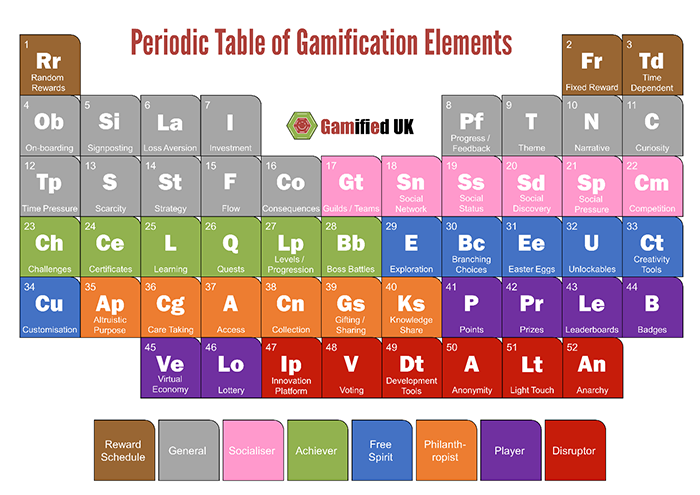
The Periodic Table of Gamification Elements (Source: Gamified UK)
I was lucky to benefit from Avery Rueb’s expertise at this stage of the project. He is a language teacher at Vanier College and the co-founder of Affordance, a Montreal-based serious games and gamification design studio. Avery led a workshop using the studio’s proprietary Game Storm tool, which shows users how to easily design a simple gamified experience. Interested teachers can request the tool through Affordance Studio’s website. Alternatively, you can use the Graduate School of Education at the University of Buffalo’s online gamification tutorial, which also comes with a free companion tool for students to use throughout the design stage.
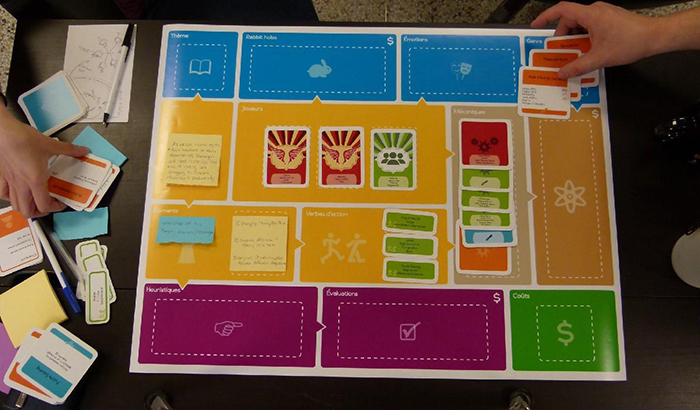
The Game Storm tool facilitates game thinking as students design their gamification experience.
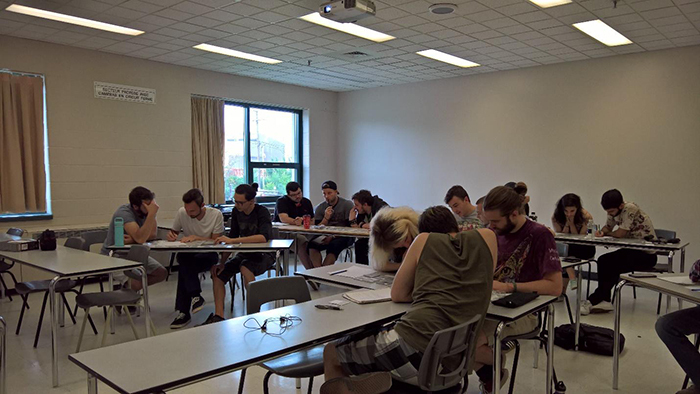
My students using the Game Storm tool during a workshop led by Avery Rueb
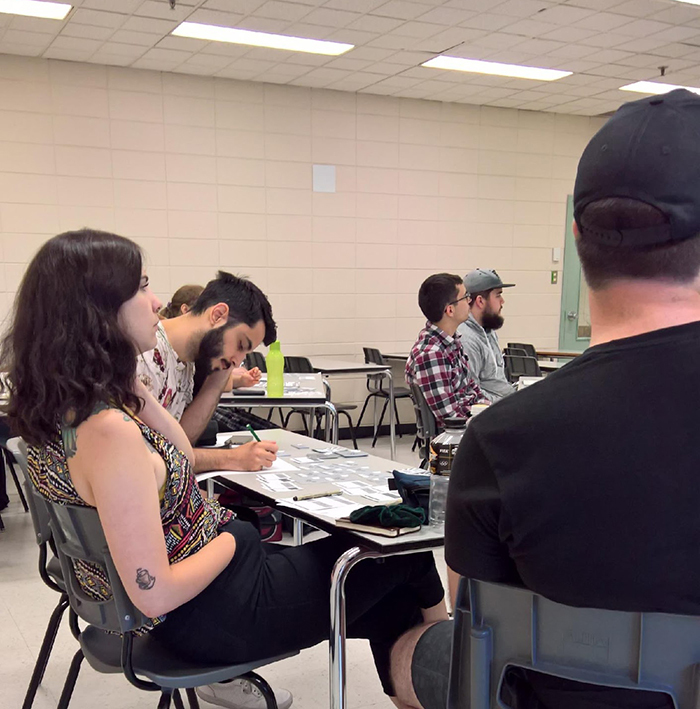
My students using the Game Storm tool during a workshop led by Avery Rueb
It is important to keep in mind that the objective of the project is not to produce a fully-functional game, but to provide an authentic learning context requiring students to use their game thinking skills. As such, the process is more important than the result. In the context of my ESL class, the final steps of the project consisted in each team presenting their project in speech and writing. These were summative evaluations.

Nicholas Losier, Philippe Pinglot and Mathieu Martel presented a cooking game concept allowing language learners to acquire vocabulary related to food.

Émilie Lafleur, Mathieu Hunter and Daniel Richard designed a game concept that allows learners to practise their listening skills by exposing them to video game characters with different accents and speech features.
Using a Gamification Project with Students in Any Field
Although I designed this project with my Video Game Design students in mind, I realized that most of them had not been exposed to gamification before. This was not a problem. Actually, learning something new was a motivating factor all of them identified in the project evaluation. Most of our students have first-hand experience with gaming. This high level of exposure to and familiarity with gaming makes it a particularly accessible and engaging layer to add to course content.
Moreover, gamification experiences range from simple to complex, which allows students of all technological skill levels to rise to the challenge. The following examples illustrate the wide range of skill levels and subject matters a gamification project can be adapted to:
- Students in Nursing modify the classic Who is it? tabletop game. They expand the characters’ profiles so players need to conduct an initial evaluation to determine their opponent’s character.
- Students in Social Science develop a trading card game based on cue cards containing key concepts of their class.
- Students in Science design a simple clicking game concept that allows their peers to review the safety protocol by selecting different objects in the right order.
As with any project, it is important to select a degree of complexity that both the teacher and students are comfortable with. Technology can be used to encourage game thinking, but should not become a hinder block. Ultimately, the design elements used in gamification give the students the freedom to experiment, the freedom of interpretation, and the freedom to fail. As a result, my students reported being much more invested in their learning, and I was able to observe that their learning was deeper and more durable. I am very enthusiastic about implementing this type of project in some of my other courses. If you are, too, I’d love to hear your comments and questions!

